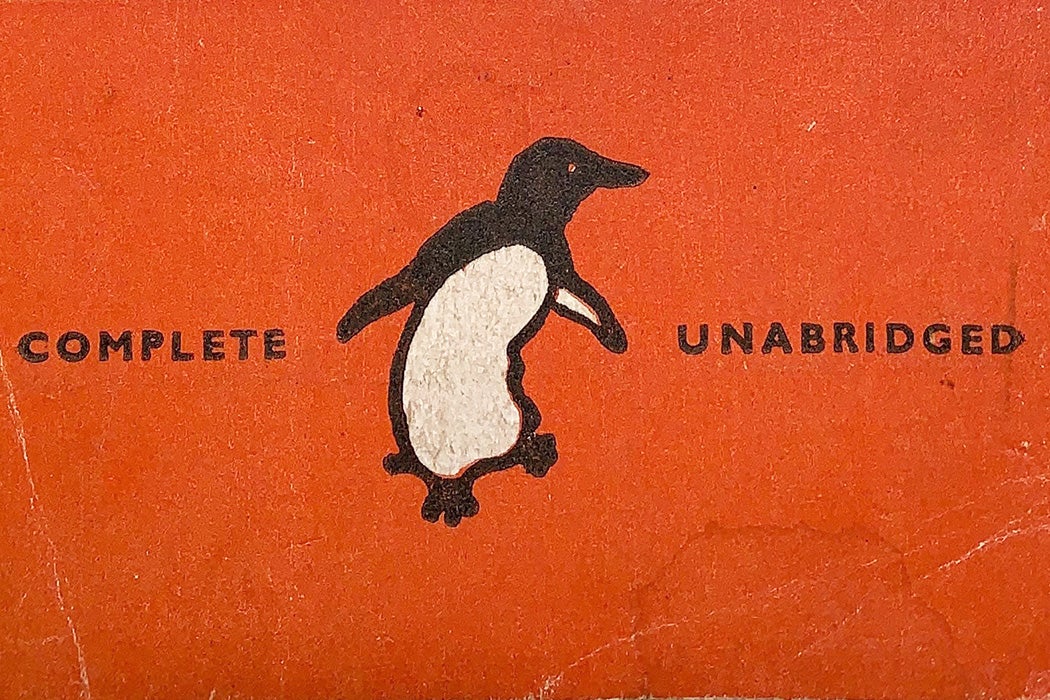At six pence, or one-fortieth of a pound each, the first ten Penguin Books were priced to move. And move they did: within six months of the introduction of Penguins to the market in 1935, the paperback company was boasting that three million copies had been sold. Unconventionally available in variety, chain stores, and newsagents as well as the more traditional bookshops, Penguins weren’t just another variation on cheap books.
Historian Richard Hornsey writes that Penguin publisher Allen Lane had an avowedly “leftist vision of social-democratic progress.” Lane aimed for a democratizing public sphere with an “engaged public readership,” though one perhaps not as left-left as the contemporary Left Book Club (1936–1948). What Lane used to reach these ends was pure capitalism: “the techniques of mass production, distribution, and retail.”
And an adorable black-and-white flightless bird.
“Choosing a brand character, and specifically a penguin, allowed [Lane] to appropriate the utopian dynamic of mass consumption and mold it to fit his own progressive cultural project,” writes Hornsey.
Penguin’s mascot became one of mid-century Britain’s most notable harbingers of social democracy. … [T]he cartoon bird provided a vital mechanism through which individual browsers learned to align themselves with its lucratively imagined public sphere.
The penguin, a simple, bold-lined cartoon illustration of a King penguin, appeared on all the books (on both front and back covers and the spine), in all the advertisements, and in all in-store promotional material. Sellers, originally required to take a minimum of ten copies of each release of ten titles, displayed their 100 books in dedicated Penguin displays, just like canned goods at the supermarket.
Penguin’s penguin remains one of the most recognizable brands in the world today. But…why a penguin?
Inspired by the existing Albatross Books, Lane’s nascent company wanted an animal for their mascot. Many years after the fact, designer Edward Young explained (as quoted by Hornsey) that after a couple hours of fruitless brainstorming, “we were in despair. Then suddenly the secretary’s voice piped up from behind the partition (her name, it should be recorded for posterity, was Joan Coles). She said, ‘What about Penguins?’”
Off went Young to the London Zoo, where the “fiercely modernist” Penguin Pond exhibit had opened the year before to general acclaim. (Penguin Pond architect Berthold Lubetkin would subsequently be asked by Lane to design the forecourt of Penguin’s new distribution center, but declined the offer.)
As Hornsey shows, there was already a strong tradition of “media star” branding mascots. These included Johnnie Walker (scotch); the Quaker (oats); the Kodak Girl (cameras); Rowntree’s Cocoa Nibs, a boy and girl in long colored scarfs and their dog, Cute, who flogged cocoa; Fry’s Girl (more chocolate); Pears Soap’s tramp-in-need-of-a-bath, Dirty Dick; Cardinal Wolsey (a historic figured appropriated to brand knitwear); and many others. The term “branding personality” wouldn’t be coined until the 1950s, but the idea was already going strong in the 1920s. Hornsey notes a similarity with movie stars: people identified with the brand-mascots of their favorite products. Some even wrote these fictional characters letters. During the fancy dress craze of the 1920s, the costumes of these ad figures were very popular, winning their wearers awards at competitive balls.
Weekly Newsletter
A penguin is, of course, a penguin, not a person. But these upright, waddling birds are comically people-like. The live specimens at the London Zoo’s Penguin Pond “provoked a range of anthropomorphic media analogies, including soldiers on parade, ‘Dominicans in feathers,’ and ‘self-conscious chorus girls.’” Edward Young captured that humorous similarity. His design was extraordinarily powerful, quickly iconic, and highly effective as a brand. People bought Penguins—which originally had no cover art—precisely because they were Penguins. For years, Penguin’s meta-advertising also showed the affable penguin reading Penguins, “announcing to prospective purchases that they and the bird were of the same species.”
Young, as it turned out, was not overly fond of how penguins smelled, but Lane “never passed up a photo opportunity with them.”







